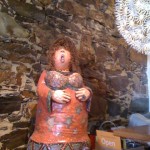Budapest doesn’t have the international cachet of nearby Prague. Yet when Hungary was still a Soviet satellite state, it was known as “the happiest barrack” in the communist camp, practicing so-called ‘goulash communism’– a mixed doctrine of communism and limited private enterprise (recently revived by Cuba). Both capital cities in the former Eastern Bloc are only a short train journey from Vienna, but after the velvet revolution, Prague streaked ahead of its neighbours, becoming a playground for German tourists and romantic Americans who thought of themselves as revisiting the Paris of the 1920s.
Compared to Prague, Budapest is rundown; but give me Budapest any time. You may come across collapsing buildings right in the centre of the city, but the locals are far friendlier than those in prettified, overrun, pricey Prague.
The heavily indebted Hungarian economy is contracting and rumours of sovereign debt default keep panicking the markets. In the dozen years since my previous trip, the only advancement seemed to be the number of luxury cars on the street. One other change was the complete absence of Gypsies from the CBD, a consequence of the recent election of a right-wing government.
The only ‘Gypsies’ you come across are in bands playing for tourists. I found a spirited group entertaining diners at one of Hungary’s best restaurants by reputation, Kárpátia. It was hunting season and the white deer cutlet was wild but tender (4500 Hungarian forint; about R150). The chef was also offering Pörkölt – a traditional wild boar stew.
Part of Budapest’s charm is its excellent restaurants – somewhat cheaper and far less modish than in touristy Prague. The presentation may not be as au courant, but Hungarian cooking has robust traditions.
Close to the National Museum is the Michelin-recommended Múzeum Kávéház és Étterem. A hot pheasant consommé (imagine white marmite with chicken) followed by a goose leg with white cabbage will restore any museum-goer. I’m not sure why we don’t do goose in South Africa. This very fine meat, widely available in Hungary, is gamier than duck, fatter than Turkey, darker than chicken.
Next to the opera house is the lively Belcanto, where the waiters burst into arias. A professional trio of musicians and singers also entertain the diners; they are not exactly background music. Here, goose leg (wonderfully crispy) with cabbage and a champagne and onion potato soufflé will set you back 5700HUF (R200). But no visit to Hungary is complete without the national dish, goulash, a beef stew (4900HUF, R175) usually served with strapatchka, which is a gnocchi-like pasta, merely smaller. The name comes from gulya meaning herdsman.
Although goulash often appears on our restaurant menus, I was thrilled to discover Cape Town finally has an authentic Hungarian kitchen serving possibly the best goulash in town.
Tucked away beneath Saint Stephen’s Church on Bree Street’s Riebeeck Square, is the cosy kitchen of energetic sisters Jutta Frensch and Inge Niklaus, who arrived in South Africa ten years ago. They hail from Muci, a hamlet in Hungary close to Lake Balaton, where their Granny Piroschka taught them the secrets of Magyar cuisine.
Many people know them from their Saturday stall at the Old Biscuit Mill, Woodstock, where they serve flammkuchen. Flammkuchen, an Alsace speciality, apparently originated from the thin discs of dough bakers used to test the temperature of an oven before baking bread. The dough is coated with a slim layer of crème fraiche and then either savoury or sweet spices are added. It is baked quickly; the oven needs to be at a high temperature, around 300°C.
In their tiny restaurant with its characterful stone walls, wooden rafters and the tables covered in newsprint paper (crayons are supplied) the sisters serve Granny Piro’s Puszta goulash (R50).
“It is not a soup and it is not a stew. It is something else,” Inge tells me as I sit down.
The goulash arrives having exactly the right consistency – not soup, not stew, simply saucy. Made with cubed beef, some bellpeppers, and the key to its heart-warming flavour, paprika paste and powder, it is thickened with onion. Paprika is usually milder than chilli, but comes in various strengths. The goulash is spicy, but not burning. It is accompanied in customary style with Alsatian spätzle. This is the same as strapatchka. To make it the batter is shredded by knife into boiling water.
The menu might be brief, but and there is more food than one can eat. Even after a hearty bowl of goulash, the hot apple strudel with vanilla ice-cream (R35) was irresistible. What the sisters do, they do superbly.
Belcanto, Dalszínház utca 8, Budapest. Tel: (36) 1 269 2786.
Kárpátia, Ferenciek tere 7-8, Budapest. Tel: (36) 1 317 3596.
Múzeum Kávéház és Étterem, Múzeum körút 12, Budapest. Tel: (36) 1 338 4221.
Piroschka’s Kitchen, 106 Bree Street, Cape Town. Tel: 083 327 3203.

